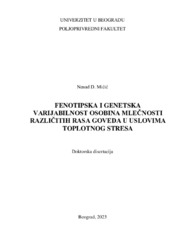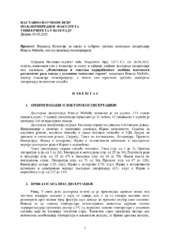Приказ основних података о дисертацији
Fenotipska i genetska varijabilnost osobina mlečnosti različitih rasa goveda u uslovima toplotnog stresa
Phenotypic and genetic variability of milk characteristics of different cattle breeds under heat stress conditions
| dc.contributor.advisor | Bogdanović, Vladan | |
| dc.contributor.other | Đedović, Radica | |
| dc.contributor.other | Stanojević, Dragan | |
| dc.contributor.other | Samolovac, Ljiljana | |
| dc.contributor.other | Kučević, Denis | |
| dc.creator | Mićić, Nenad | |
| dc.date.accessioned | 2023-11-28T17:18:56Z | |
| dc.date.available | 2023-11-28T17:18:56Z | |
| dc.date.issued | 2023-09-01 | |
| dc.identifier.uri | https://eteze.bg.ac.rs/application/showtheses?thesesId=9356 | |
| dc.identifier.uri | https://fedorabg.bg.ac.rs/fedora/get/o:31792/bdef:Content/download | |
| dc.identifier.uri | https://plus.cobiss.net/cobiss/sr/sr/bib/130875913 | |
| dc.identifier.uri | https://nardus.mpn.gov.rs/handle/123456789/21894 | |
| dc.description.abstract | Cilj ovog istraživanje je bio da se utvrdi fenotipska i genetska ispoljenost i varijabilnost osobina mlečnosti krava različitih rasa u uslovima toplotnog stresa. Istraživanje je sprovedeno na setu podataka koji je sadržao proizvodne i podatke o poreklu krava koje su bile pod redovnom kontrolom mlečnosti (AT4 metod) u periodu od početka 2013. do kraja 2019. godine. Analizom su obuhvaćena grla četiri rase goveda, i to: simentalske, holštajn-frizijske, crvenog holštajna i braon svis rase. Svi podaci o grlima i njihovoj proizvodnji su preuzeti od 27 osnovnih odgajivačkih organizacija koje sprovode glavni odgajivački program na gazdinstvima iz tri upravna okruga Republike Srbije: Mačvanski, Šumadijski i Podunavski upravni okrug. Podaci iz kontrola mlečnosti obuhvataju informacije o proizvodnji mleka na nivou kontrolnih dana redovne referentne AT4 metode. Finalni set podataka sadržao je 717153 podatka o mlečnosti na dan kontrole. Merenje ambijentalne temperature i relativne vlažnosti vazduha u stajama za smeštaj krava obavljano je uz pomoć DATALOGER uređaja za automatsko registrovanje mikroklimatskih parametara. Merenja temperature i vlažnosti vazduha unutar objekta za držanje krava su kontinuirano vršena na svakih 60 minuta 365 dana godišnje tokom svih godina uključenih u istraživački period. Na osnovu izmerenih vrednosti temperature i vlažnosti vazduha za svaki sat u toku dana izračunate su vrednosti temperaturno – humidnog indeksa (THI). Za potrebu jasnijeg i preciznijeg prikaza uticaja toplotnog stresa i prikaza svih rezultata ukupni set podataka je analiziran kroz tri perioda posmatranja: dvanaestomesečni period cele godine (N=717153), petomesečni topli period godine koji je obuhvatao period od maja do septembra (n=308954) i sedmomesečni hladni period godine od oktobra do aprila (n=408199). Istraživanjem je obuhvaćeno devet osobina mlečnosti krava i to: dnevni prinos mleka u kontrolnom danu (kg/grlu/dan), sadržaj mlečne masti u kontrolnom danu (%), sadržaj proteina mleka u kontrolnom danu (%), prinos mleka u celoj laktaciji (kg), prinos mleka u standardnoj laktaciji od 305 dana (kg), sadržaj mlečne masti u standardnoj laktaciji od 305 dana (%), sadržaj proteina mleka u standardnoj laktaciji od 305 dana (%), prinos mlečne masti u standardnoj laktaciji od 305 dana (kg), prinos proteina mleka u standardnoj laktaciji od 305 dana (kg). Definisana je nova osobina koja procenjuje dnevni gubitak u proizvodnji mleka - ,,milk production decline” (MPD) i u direktnoj je vezi sa vrednošću THI. Pokazatelji deskriptivne statistike za posmatrane osobine i mikroklimatske faktore izračunati su primenom PROC MEANS procedure SAS programskog paketa. U istraživanju je ispitan fiksni uticaj okruga, rase, godine teljenja, sezone teljenja, laktacije po redu, meseca kontrole mleka, faze laktacije i nivoa THI u okviru PROC GLM procedure SAS programskog paketa. Za MPD izvršena je procena heritabiliteta upotrebom sire modela u okviru VARCOMP procedure SAS programskog paketa i primenom REML metodologije. U istraživanju je utvrđen najviši prosečan dnevni prinos mleka kod grla holštajn rase od 17,46 kg, dok je najviši dnevni sadržaj masti i proteina utvrđen kod grla braon svis rase (4,11% i 3,24%). Najvišu dnevnu proizvodnju ostvarila su grla gajena u Podunavskom okrugu (18,33 kg). Najvišu proizvodnju su ostvarila grla koja su se telila u toku jeseni. Najviše dnevne prinose mleka ostvarile su krave tokom redovne kontrole tokom februara meseca (17,78 kg/grlu/dan). Sadržaj masti je imao niže vrednosti od maja do septembra (3,98%), što odgovara periodu negativnog toplotnog uticaja. Najviša prosečna vrednost THI-ija utvrđena je u toku toplog perioda godine (73,38). Najvišu dnevnu proizvodnju mleka (17,98 kg) su imala grla koja su proizvodila u intervalu THI od 41-60... | sr |
| dc.description.abstract | As part of the dissertation, research was conducted aimed at determining the phenotypic and genetic expression and variability of milk yield traits of cows of different breeds under heat stress conditions. The study was carried out with a dataset containing production and origin data of cows subjected to regular control of milk yield (AT4 method) in the period from the beginning of 2013 to the end of 2019. The analysis included the animals of four cattle breeds, namely: Simmental, Holstein-Friesian, Red Holstein and Brown Swiss. All data on cows and their production were obtained from 27 basic breeding organizations implementing the main breeding program in farms from three administrative districts of the Republic of Serbia: Mačva, Šumadija and Danube administrative districts. The data of milk yield controls contain information on milk production at the level of control days of the regular reference AT4 method. The final data set contained 717153 milk yield data on the control day. The measurement of the ambient temperature and relative humidity in the barns for housing the cows was carried out using the DATALOGER device for automatic registration of microclimatic parameters. The measurements of air temperature and relative humidity inside the stall storage facility were continuously performed every 60 minutes for 365 days a year during all years of the study period. Based on the measured air temperature and relative humidity values for each hour of the day, the values of TH index were calculated. For a clearer and more precise representation of the influence of heat stress and to present all the results, the whole data set was analyzed using three observation periods: the period of the whole year (N=717153), and the warm period of the year, which included the period from May to September (n=308954), and the cold period of the year, which included the period from October to April (n=408199). The research included nine milk traits of cows, namely: daily milk yield on the control day (kg/head/day), milk fat content on the control day (%), milk protein content on the control day (%), milk yield in the entire lactation (kg), milk yield in a standard lactation of 305 days (kg), milk fat content in a standard lactation of 305 days (%), milk protein content in a standard lactation of 305 days (%), milk fat yield in a standard lactation of 305 days (kg), milk protein yield in a standard lactation of 305 days (kg). A new trait has been defined that estimates the daily milk production decline (MPD) and is directly related to the THI value. Indicators of descriptive statistics for the observed characteristics and microclimatic parameters were calculated using the PROC MEANS procedure of the SAS program package. The study examined the fixed effect of district, breed, year of calving, season of calving, lactation in order, month of milk control, stage of lactation, THI level within in the PROC GLM procedure of the SAS software package. For MPD, a heritability assessment was performed using a sire model within the VARCOMP procedure of the SAS program package and applying the REML methodology. In the research, the highest average daily milk yield was found in Holstein cattle breed of 17,46 kg/head/day, while the highest daily fat and protein content was found in Brown Swiss cattle breed (4,11% and 3,24%). The highest daily production was achieved by head raised in the Danube district (18,33 kg). The highest production was achieved by cows that calved in the fall season. The highest daily milk yields were achieved by cows during regular control during the month of February (17,78 kg/head/day). The fat content had lower values from May to September (3,98%), which corresponds to the period of negative thermal influence of heat stress. The highest average value of THI was determined during the warm period of the year (73,38). The highest daily milk production (17,98 kg/head/day) was achieved by cows that produced in the THI interval of 41-60... | en |
| dc.format | application/pdf | |
| dc.language | sr | |
| dc.publisher | Универзитет у Београду, Пољопривредни факултет | sr |
| dc.rights | openAccess | en |
| dc.rights.uri | https://creativecommons.org/licenses/by-nc/4.0/ | |
| dc.source | Универзитет у Београду | sr |
| dc.subject | Rase goveda, varijabilnost osobina mlečnosti, dnevna proizvodnja mleka, toplotni stres, THI, gubici u proizvodnji mleka | sr |
| dc.subject | Cattle breeds, variability of milk characteristics, daily milk production, heat stress, THI, milk production decline (MPD) | en |
| dc.title | Fenotipska i genetska varijabilnost osobina mlečnosti različitih rasa goveda u uslovima toplotnog stresa | sr |
| dc.title.alternative | Phenotypic and genetic variability of milk characteristics of different cattle breeds under heat stress conditions | en |
| dc.type | doctoralThesis | |
| dc.rights.license | BY-NC | |
| dc.identifier.fulltext | http://nardus.mpn.gov.rs/bitstream/id/157154/Disertacija_14437.pdf | |
| dc.identifier.fulltext | http://nardus.mpn.gov.rs/bitstream/id/157155/Izvestaj_Komisije_14437.pdf | |
| dc.identifier.rcub | https://hdl.handle.net/21.15107/rcub_nardus_21894 |



